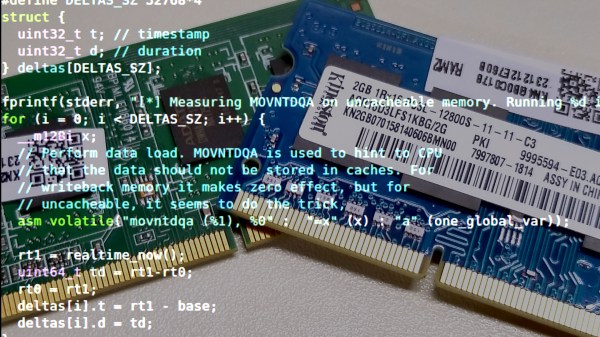Did artificial intelligence just jump the shark? Maybe so, and it came from the legal world of all places, with this report of an AI-generated victim impact statement. In an apparent first, the family of an Arizona man killed in a road rage incident in 2021 used AI to bring the victim back to life to testify during the sentencing phase of his killer’s trial. The video was created by the sister and brother-in-law of the 37-year-old victim using old photos and videos, and was quite well done, despite the normal uncanny valley stuff around lip-syncing that seems to be the fatal flaw for every deep-fake video we’ve seen so far. The victim’s beard is also strangely immobile, which we found off-putting.
Meltdown18 Articles
Boss Byproducts: Corium Is Man-Made Lava
So now we’ve talked about all kinds of byproducts, including man-made (Fordite), nature-made (fulgurites), and one that’s a little of both (calthemites). Each of these is beautiful in its own way, but I’m not sure about the beauty and merit of corium — that which is created in a nuclear reactor core during a meltdown.

Corium has the consistency of lava and is made up of many things, including nuclear fuel, the products of fission, control rods, any structural parts of the reactor that were affected, and products of those parts’ reaction with the surrounding air, water, and steam.
If the reactor vessel itself is breached, corium can include molten concrete from the floor underneath. That said, if corium is hot enough, it can melt any concrete it comes in contact with.
So, I had to ask, is there corium jewelry? Not quite. Corium is dangerous and hard to come by. But that doesn’t stop artisans from imitating the substance with other materials.
This Week In Security: Zombieload, And Is Your Router Leaking?
Do you know what your router is doing? We have two stories of the embedded devices misbehaving. First, Linksys “Smart” routers keep track of every device that connects to its network. Right, so does every other router. These routers, however, also helpfully expose that stored data over JNAP/HNAP.
Some background is needed here. First, HNAP is the Home Network Administration Protocol, designed to manage routers and network devices. Originally designed by Pure Networks, HNAP is a SOAP based protocol, and has been part of security problems in the past. You may also see the term JNAP. It seems that JNAP is the JSON Network Administration Protocol, identical to HNAP except for using JSON instead of SOAP.
The odd part is that this is an old problem. CVE-2014-8244 was disclosed and fixed in 2014. According to the writeup at Badpackets.net, the problem was re-discovered as a result of observing active network attacks targeting JNAP. When Linksys was informed of the rediscovered problem, they responded that the problem was fixed in 2014, and devices with updated firmware and default settings are not accessible from the public internet. The presence of over 20,000 devices leaking data casts doubt on their response. Continue reading “This Week In Security: Zombieload, And Is Your Router Leaking?”
Spoiler, Use-After-Free, And Ghidra: This Week In Computer Security
The past few days have been busy if you’re trying to keep up with the pace of computer security news. Between a serious Chromium bug that’s actively being exploited on Windows 7 systems, the NSA releasing one of their tools as an open source project, and a new Spectre-like speculative execution flaw in Intel processors, there’s a lot to digest.
Continue reading “Spoiler, Use-After-Free, And Ghidra: This Week In Computer Security”
Peering Into A Running Brain: SDRAM Refresh Analyzed From Userspace
Over on the Cloudflare blog, [Marek] found himself wondering about computer memory, as we all sometimes do. Specifically, he pondered if he could detect the refresh of his SDRAM from within a running program. We’re probably not ruining the surprise by telling you that the answer is yes — with a little more than 100 lines of C and help from our old friend the Fast Fourier Transform (FFT), [Marek] was able to detect SDRAM refresh cycles every 7818.6 ns, lining right up with the expected result.
The “D” in SDRAM stands for dynamic, meaning that unless periodically refreshed by reading and writing, data in the memory will decay. In this kind of memory, each bit is stored as a charge on a tiny capacitor. Given enough time (which varies with ambient temperature), this charge can leak away to neighboring silicon, turning all the 1s to 0s, and destroying the data. To combat this process, the memory controller periodically issues a refresh command which reads the data before it decays, then writes the data back to fully charge the capacitors again. Done often enough, this will preserve the memory contents indefinitely. SDRAM is relatively inexpensive and available in large capacity compared to the alternatives, but the drawback is that the CPU can’t access the portion of memory being refreshed, so execution gets delayed a little whenever a memory access and refresh cycle collide.
Chasing the Correct Hiccup
[Marek] figured that he could detect this “hiccup,” as he calls it, by running some memory accesses and recording the current time in a tight loop. Of course, the cache on modern CPUs would mean that for a small amount of data, the SDRAM would never be accessed, so he flushes the cache each time. The source code, which is available on GitHub, outputs the time taken by each iteration of the inner loop. In his case, the loop typically takes around 140 ns.
Hurray! The first frequency spike is indeed what we were looking for, and indeed does correlate with the refresh times.
The other spikes at 256kHz, 384kHz, 512kHz and so on, are multiplies of our base frequency of 128kHz called harmonics. These are a side effect of performing FFT on something like a square wave and totally expected.
As [Marek] notes, the raw data doesn’t reveal too much. After all, there are a lot of things that can cause little delays in a modern multitasking operating system, resulting in very noisy data. Even thresholding and resampling the data doesn’t bring refresh hiccups to the fore. To detect the SDRAM refresh cycles, he turned to the FFT, an efficient algorithm for computing the discrete Fourier transform, which excels at revealing periodicity. A few lines of python produced the desired result: a plot of the frequency spectrum of the lengthened loop iterations. Zooming in, he found the first frequency spike at 127.9 kHz, corresponding to the SDRAMs refresh period of 7.81 us, along with a number of other spikes representing harmonics of this fundamental frequency. To facilitate others’ experiments, [Marek] has created a command line version of the tool you can run on your own machine.
If this technique seems familiar, it may be because it’s similar the the Rowhammer attack we covered back in 2015, which can actually change data in SDRAM on vulnerable machines by rapidly accessing adjacent rows. As [Marek] points out, the fact that you can make these kinds of measurements from a userspace program can have profound security implications, as we saw with the meltdown and spectre attacks. We have to wonder what other vulnerabilities are lying inside our machines waiting to be discovered.
Thanks to [anfractuosity] for the tip!
Foreshadow: The Sky Is Falling Again For Intel Chips
It’s been at least a month or two since the last vulnerability in Intel CPUs was released, but this time it’s serious. Foreshadow is the latest speculative execution attack that allows balaclava-wearing hackers to steal your sensitive information. You know it’s a real 0-day because it already has a domain, a logo, and this time, there’s a video explaining in simple terms anyone can understand why the sky is falling. The video uses ukuleles in the sound track, meaning it’s very well produced.
The Foreshadow attack relies on Intel’s Software Guard Extension (SGX) instructions that allow user code to allocate private regions of memory. These private regions of memory, or enclaves, were designed for VMs and DRM.
How Foreshadow Works
The Foreshadow attack utilizes speculative execution, a feature of modern CPUs most recently in the news thanks to the Meltdown and Spectre vulnerabilities. The Foreshadow attack reads the contents of memory protected by SGX, allowing an attacker to copy and read back private keys and other personal information. There is a second Foreshadow attack, called Foreshadow-NG, that is capable of reading anything inside a CPU’s L1 cache (effectively anything in memory with a little bit of work), and might also be used to read information stored in other virtual machines running on a third-party cloud. In the worst case scenario, running your own code on an AWS or Azure box could expose data that isn’t yours on the same AWS or Azure box. Additionally, countermeasures to Meltdown and Spectre attacks might be insufficient to protect from Foreshadown-NG
The researchers behind the Foreshadow attacks have talked with Intel, and the manufacturer has confirmed Foreshadow affects all SGX-enabled Skylake and Kaby Lake Core processors. Atom processors with SGX support remain unaffected. For the Foreshadow-NG attack, many more processors are affected, including second through eighth generation Core processors, and most Xeons. This is a significant percentage of all Intel CPUs currently deployed. Intel has released a security advisory detailing all the affected CPUs.
Hackaday Links: February 18, 2018
Hacker uses pineapple on unencrypted WiFi. The results are shocking! Film at 11.
Right on, we’ve got some 3D printing cons coming up. The first is MRRF, the Midwest RepRap Festival. It’s in Goshen, Indiana, March 23-25th. It’s a hoot. Just check out all the coverage we’ve done from MRRF over the years. Go to MRRF.
We got news this was going to happen last year, and now we finally have dates and a location. The East Coast RepRap Fest is happening June 22-24th in Bel Air, Maryland. What’s the East Coast RepRap Fest? Nobody knows; this is the first time it’s happening, and it’s not being produced by SeeMeCNC, the guys behind MRRF. There’s going to be a 3D printed Pinewood Derby, though, so that’s cool.
జ్ఞా. What the hell, Apple?
Defcon’s going to China. The CFP is open, and we have dates: May 11-13th in Beijing. Among the things that may be said: “Hello Chinese customs official. What is the purpose for my visit? Why, I’m here for a hacker convention. I’m a hacker.”
Intel hit with lawsuits over security flaws. Reuters reports Intel shareholders and customers had filed 32 class action lawsuits against the company because of Spectre and Meltdown bugs. Are we surprised by this? No, but here’s what’s interesting: the patches for Spectre and Meltdown cause a noticeable and quantifiable slowdown on systems. Electricity costs money, and companies (server farms, etc) can therefore put a precise dollar amount on what the Spectre and Meltdown patches cost them. Two of the lawsuits allege Intel and its officers violated securities laws by making statements or products that were false. There’s also the issue of Intel CEO Brian Krzanich selling shares after he knew about Meltdown, but before the details were made public. Luckily for Krzanich, the rule of law does not apply to the wealthy.
What does the Apollo Guidance Computer look like? If you think it has a bunch of glowey numbers and buttons, you’re wrong; that’s the DSKY — the user I/O device. The real AGC is basically just two 19″ racks. Still, the DSKY is very cool and a while back, we posted something about a DIY DSKY. Sure, it’s just 7-segment LEDs, but whatever. Now this project is a Kickstarter campaign. Seventy bucks gives you the STLs for the 3D printed parts, BOM, and a PCB. $250 is the base for the barebones kit.














